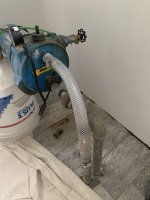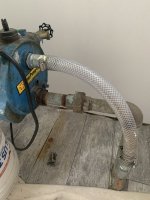james wentworth
Jbone36
In our summer use only cottage, I have a 70' double drop deep well which connects to the jet pump inside the house. The old setup was a 1/2 hp Simer pump that sat on top of small horizontal water tank, maybe 5 or 6 gallons. The piping used from the 2 pipe outlet to pump was galvanized with unions. My grandpa would disconnect the unions every year to drain and winterize it, but over time the unions started leak from the frequent threading on/off.
I have a new F&W 1/2 hp pump and a vertical water tank that I plan to install. The tank will be about 5' away from the pump. I'm a plumbing novice, and with that in mind, I'm trying to determine which type of piping I should use to connect the pump to the drop pipes, and then from the pump to the water tank. PEX is used throughout the rest of the cottage.
If possible, could someone run me through the types of valves / connections I should have between the drop pipe & pump and pump & tank? I know a check valve is needed between the tank and pump. My goal is to be able to winterize without disconnecting any of the major plumbing all while doing it right.
Attached is a pic of how my old setup kind of was (some of the galvanized piping removed).
Thanks for any help!
I have a new F&W 1/2 hp pump and a vertical water tank that I plan to install. The tank will be about 5' away from the pump. I'm a plumbing novice, and with that in mind, I'm trying to determine which type of piping I should use to connect the pump to the drop pipes, and then from the pump to the water tank. PEX is used throughout the rest of the cottage.
If possible, could someone run me through the types of valves / connections I should have between the drop pipe & pump and pump & tank? I know a check valve is needed between the tank and pump. My goal is to be able to winterize without disconnecting any of the major plumbing all while doing it right.
Attached is a pic of how my old setup kind of was (some of the galvanized piping removed).
Thanks for any help!


